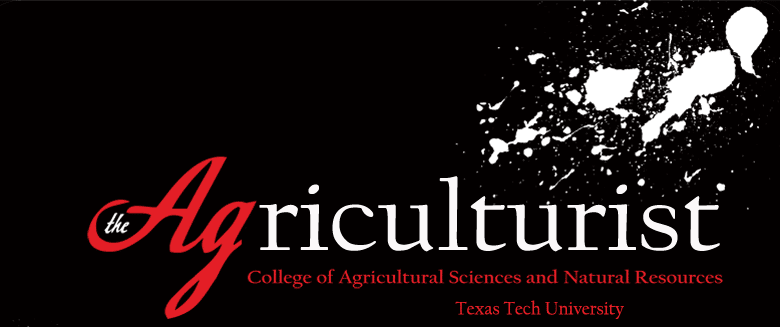
Table of Contents
Features
Agriculture: We Can Sustain It
Socializing Agriculture
Painter of Quiet Places
An Apple a Day
Sustaining the Four Sixes
Hitting Pay Dirt
The New Face of Agriculture
The Winds of Change
Avatars Animate Agriculture
Professors in Training
Going Green
Saving Lives One Plan at a Time
Protecting Our Food
Quality Cells, Consumer Buys
Tech's New Mate
Micro ZAP
Food Saftey in Mexico
Expanding Opportunities
No Bits About It
The Family Farm Fire Man
Around the World with CASNR
Live From Texas Tech
Looking Forward
Getting Schooled
A Cotton Senstaion
Living and Learning
More Than a Trophy
Online Exclusives
Alumni Lance Barnett: Unpeeled
Agricultural Education and CommunicationDepartment Shines in 2010
CSI: Classroom Soil Investigation
Facing Nature
GINuine
Healing Hooves
Parking and Partying in Style
Raider Red Meats
Standing TALL
Tech Takes Flight
West Texas Cotton Goes Global
Facing Nature
By Sam Gadd
He traveled a jagged road from his home in New England to West Texas. He has researched Canada Lynx in northern Maine, trapped Black Bears in Arkansas, studied Kit Foxes and coyotes in Utah, and finally made his way to Lubbock. Michael Panasci, a 32-year-old doctorate student from Maine, is now a full-time teacher’s assistant for the Department of Natural Resources Management at Texas Tech University.
Panasci received a bachelor’s degree from the University of Connecticut in Ecology and Evolutionary Biology.
“After that,” Panasci said, “I took five years off and worked in the field and worked, among other things, on trapping Black Bears for six months in Arkansas.”
That time off from academics was not without its moments of stark terror and adrenaline.
Panasci described an encounter with a Black Bear in the White River National Wildlife Refuge.
During a relocation program, Panasci said, he and a partner used non-lethal snares to capture and tag bears utilizing whole fish as bait.
“Some bears were quite easy to catch, and others were very difficult,” Panasci said. “One particular bear was very good at getting the fish bait without stepping in the snare.”
After they had tried different setups with the snare and moving it around to different locations, Panasci said, the two partners realized the bear was simply treating the sound of the all-terrain vehicle they were using like a dinner bell.
“On several occasions, the bear came very close to us, around 20 to 30 yards,” Panasci said.
He was determined to capture the bear that had been so bold while avoiding him, and came up with a new plan to immobilize the bear so it could be captured.
“My thought was to stalk close to the bear with a blowgun and dart the animal that way,” Panasci said. “Everyone else thought I was crazy, but I was determined, and had to do it alone. I practiced with the blowgun in our house for several hours using water-filled darts, simulating the weight of a drug-filled dart, and got to be quite proficient.”
He said his attempts to get close to the bear were spoiled when the sound of his boots crashing through the litter on the ground spooked the bear.
“So off came the boots. It made the difference, and I was soon about eight yards from this bear and took my shot. What a rush,” Panasci said.
“The bear took off and was soon dozing from the Ketamine/Xylazine mixture that I dosed it with.”
Panasci said as he looks back, he is not sure if he would do it again, but the rush of the stalk was incredible.
After his time in the field, he received his master’s degree from Texas Tech and plans to complete his doctorate sometime in 2013.
Panasci said the department’s high-profile professors drew him to the College of Agricultural Sciences and Natural Resources after his brief time away from academia.
“My interests are in carnivore ecology and predator/prey relationships,” Panasci said. “Warren [Ballard, Ph.D.] was one of the top guys in the field. I contacted him, and basically he liked what he saw and so I came down and I’ve been here since.”
Panasci said he always knew he loved to be outside, learning about nature and helping conserve the planet’s precious natural resources.
“I knew I wanted to get into wildlife biology from the beginning, hunting and fishing in the backwoods of Maine,” Panasci said.
Philip Gipson, Ph.D., the chair of the Department of Natural Resources, said he feels Panasci is more like a friend than a colleague.
“I’ve had experience with coyotes in the past, professional research experience with them, and that’s what Mike was working on, so we had a lot in common,” Gipson said.
Panasci said an alliance with the Lubbock Safari Club is crucial to the college because the club is one of the leaders in the advocacy of hunting and, more importantly, wildlife conservation.
“Hunting goes hand-in-hand with conservation,” Panasci stated. “Traditionally hunters have been the most important stakeholders both operationally and financially.”
Texas Tech gained a seasoned field veteran in Mike Panasci. His experience in natural resource and wildlife management is not just limited to the classroom, and he has demonstrated that he is not afraid to take a chance when the benefits outweigh the risks. Even if it means having a showdown with a bear in the mountains of Arkansas.